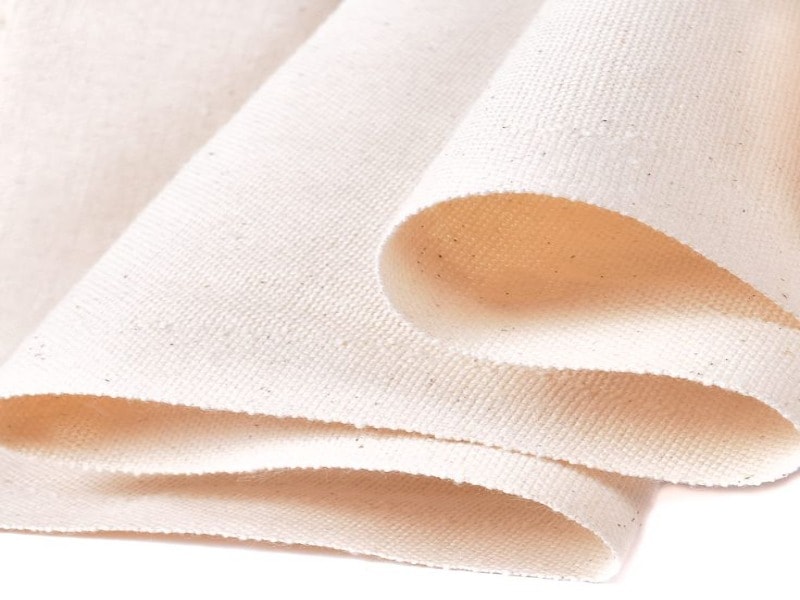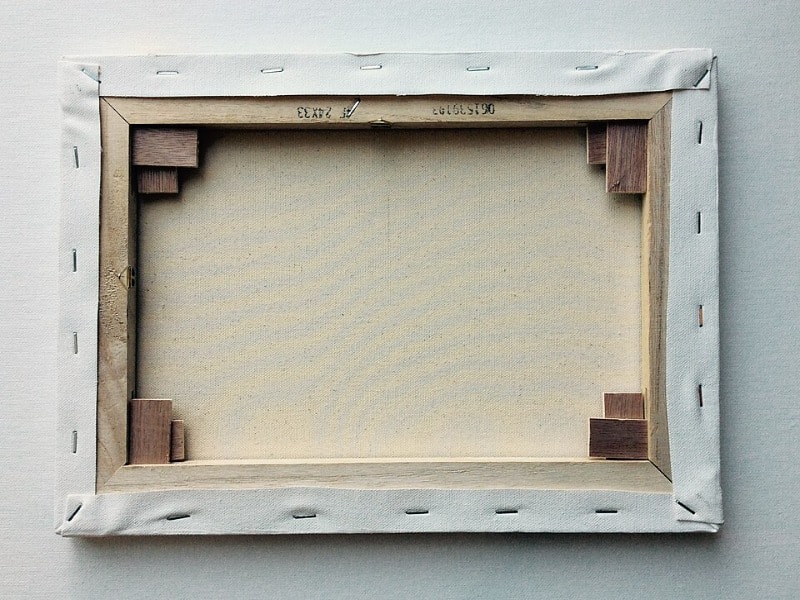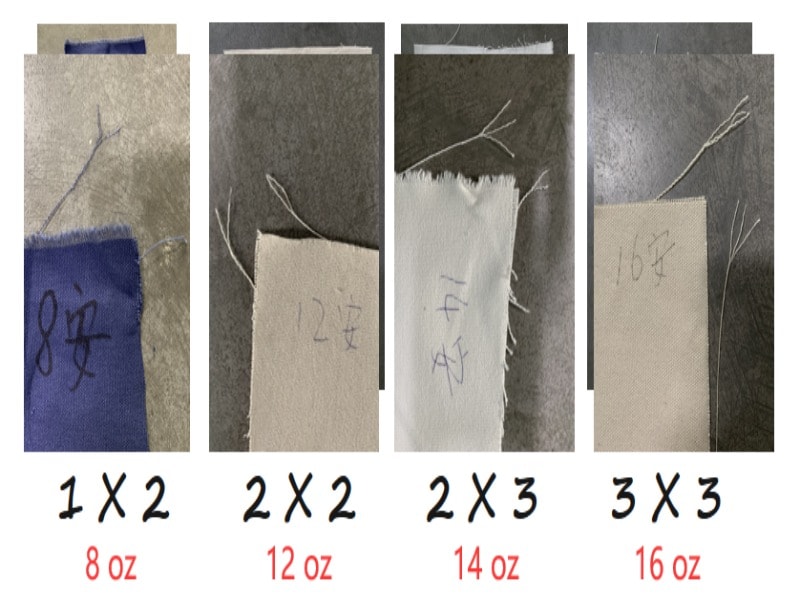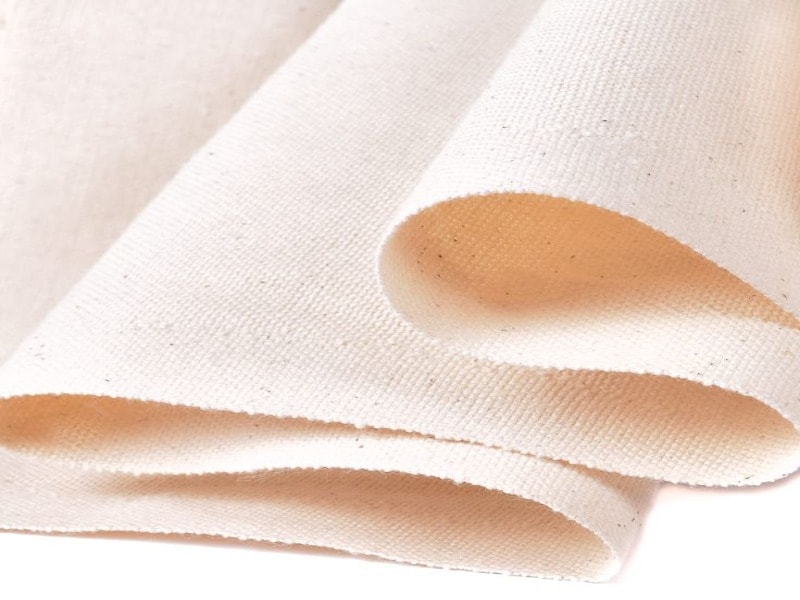
Canvas is used in tote bags, shoes, and tents, and even fine art for many reasons. While some people adore its durability, others prefer the fabric for its versatility.
This makes us wonder, “What makes canvas this popular?” The answer primarily lies in what this rugged fabric is made of. Modern canvas is no longer just about cotton fabrics. Today’s blends include linen, polyester, and performance-grade finishes for added durability and eco-friendly appeal.
In this guide, we will break down what is canvas made of, how it is made, and how it performs best in the fashion and art industries.
What Is Canvas Fabric?

Canvas fabric is a plain weave built with thick yarns that interlock in a crisscross pattern. This results in a well-structured and firm surface that retains its shape for a long time, even as thinner fabrics have worn down.
You’ll find it in places that call for grit. Think of canvas stretched across a wooden frame in a painting studio or folded into a tote bag at the market. You might spot it as sailcloth, tent material, or in a pair of rugged sneakers.
Canvas fabric is durable because the threads in duck canvas are tightly woven.
The word itself comes from cannabis, a nod to the fabric’s early life as hemp-based cloth. Hemp plants gave way to cotton and linen canvas over time, especially in the 20th century. This was due to the boom in cotton canvas, which led to a shift in focus from toughness alone to texture and accessibility.
Duck canvas is smoother than burlap. At the same time, it holds more weight than poplin. That’s what gives it a robust grip, thickness, and value across industries.
So, if you’re wondering what is canvas made of, the answer starts with structure: tightly woven, cotton duck, and endlessly reliable.
What Material Is Canvas Made Of?

Canvas carries the fingerprints of history in every thread, yet its composition continues to evolve with each weave and century.
Traditional Fibers
Canvas began as a hemp or flax fabric. Artisans wove thick hemp yarn into a plain pattern. That made it reliable for work sails and tents.
Flax (linen) offered a smoother finish. These fibers laid the foundation for canvas durability centuries ago.
Linen or Cotton Canvas
Most modern canvas uses cotton or linen.
Cotton is breathable and biodegradable, while linen canvas is slightly stiff and has a natural luster. Both options work well for tote bags, upholstery, and fashion accessories. Their natural properties support eco‑friendly use.
Cotton canvas is a popular choice among artists. Linen is particularly suitable for artwork destined for museums and collectors who value long-lasting, archival-quality pieces.
Polyester Canvas
Polyester canvas offers strong, water-resistant performance. It resists mildew and dries quickly.
Manufacturers prefer it for low‑cost and functional goods. Although it lacks the organic feel of cotton or linen, it remains useful in outdoor gear and industrial fabrics where durability is a priority.
Blend Canvas
Blended canvas combines the strengths of different fibers. A cotton‑polyester mix delivers breathability and moisture resistance while costing less than pure cotton.
Producers often use blends to balance eco‑credentials with utility. This makes it ideal for budget‑friendly tote bags or mid-range gear.
How Is Canvas Fabric Made?

Canvas fabric does not come off the loom ready for your tote bag or tent. Its strength begins with the plain weave, a crisscross pattern that uses thick canvas yarn in both the warp and weft directions. This basic structure gives canvas its dense, balanced texture and ability to resist tearing, even under stress.
The Plain Weave Behind Canvas Strength
Canvas fabric follows a different rule than delicate fabrics, which rely on thread count for evaluation. Canvas fabric has a thread count ranging from 50 to 100.
You measure the canvas fabric by weight. That’s why you’ll often see labels like ‘8 oz’ or ’12 oz’ canvas. That’s ounces per square yard.
A heavier number usually indicates a sturdier feel, which makes sense when dealing with gear that needs to withstand outdoor conditions or daily wear.
Pre-Treatments That Shape the Final Fabric
Canvas goes through a few finishing touches before turning into your favorite bag, shoe, or painting frame.
Canvas makers bleach or dye lighter indoor versions for a clean, even tone. For outdoor-ready canvas, they apply wax treatments or water-repellent coatings to help it shrug off rain, sun, and spills.
At first glance, the canvas looks like a no-fuss material. However, beneath that simplicity lies a process that requires careful attention to get right. Whether you’re holding cotton canvas or a rugged poly blend, every piece starts the same way.
Canvas’s tightly woven base withstands daily wear, heavy loads, and harsh weather.
Types of Canvas Material
Take a look at this quick comparison to see how different kinds of canvas fabric stack up.
| Type | Material | Common Use |
|---|---|---|
| Cotton Duck Canvas | 100% cotton | Tote bags, sneakers, upholstery |
| Linen Canvas | Linen | High-end art, shoes |
| Polyester or Blend Canvas | Poly/cotton blends | Outdoor bags, tents, and promotional bags |
| Blended Canvas | Poly-cotton blends | Tents, everyday carry items |
| Waxed Canvas | Cotton or blend | Backpacks, tool rolls, work aprons |
Why Canvas Is So Popular?
Here is why fashion and art enthusiasts love canvas:
Built for Wear and Tear
Canvas fabric holds up where others give out. Its plain weave and thick yarns create a surface that feels strong in your hands.
From work aprons to outdoor gear, this fabric takes a beating and still looks good. You’ll find heavier types, such as cotton canvas, used in seats or tool bags.
Friendly to the Planet

Canvas is typically made from cotton, which means it can decompose naturally over time. It lasts long enough to replace dozens of plastic alternatives. That makes cotton canvas a go-to choice for anyone who wants to use better materials without sacrificing function.
Easy to Work With
Whether it’s dyed, printed, or stretched across a wooden frame, canvas fabric is easy to handle. That’s why artists use canvas the most.
Brands choose it for custom totes or banners. It takes color well and retains its shape, regardless of how you use it.
Affordable Pricing
When purchased in bulk, canvas is a cost-effective option. For factories and small businesses, this kind of reliability at a low price is hard to beat.
Where You’ll See Canvas Used

Whether it’s cotton-based canvas or a tough canvas sailcloth, the fabric doesn’t sit on the sidelines. It serves a purpose.
Below are some of the most common categories where canvas fabric proves its worth:
Fashion
From aprons to backpacks, heavy cotton fabrics are a staple of personal style. Linen and cotton derive from natural sources, giving each item character and texture.
Cotton duck, which stretches without losing form, is a favorite in bag production. That’s why fashion catalogs often refer to cotton canvas as a reliable, washable choice.
Art
Modern artists still rely on canvas stretched over wood panels. The surface, made from linen canvas or natural cotton, is smooth enough for oil paint and durable enough to last for decades. This popular painting medium gained momentum in the early 20th century, during the cotton boom, and remains a staple.
Outdoor Gear
Canvas sailcloth and tent material rely on dense canvas yarn woven with attention to warp direction. It’s no surprise that this heavy-duty fabric appears in everything from hiking backpacks to camping shelters.
Home Decor
In the manufacturing industry, woven canvas finds a second life in curtains, cushions, and covers. These are often classified in two ways: by weight, so a number (like 12 oz), or by texture.
Numbers run in reverse, meaning a 10 canvas is lighter than a 4. That’s how you match weight to purpose.
Discover the beauty of natural canvas in our eco-friendly tote bags.
FAQs
Is canvas made from cotton or polyester?
Modern canvas is usually made from cotton, polyester, or a cotton-poly blend. Cotton canvas is a natural and biodegradable material, while polyester adds water resistance. Blended options are popular due to their cost-effectiveness and strength.
Is canvas a natural or synthetic fabric?
Canvas fabric can be natural if made from cotton or linen. Manufacturers typically produce synthetic canvas from polyester and other synthetic materials. Most blends combine both to improve durability and function.
What makes canvas different from denim?
Canvas uses a plain weave and feels stiffer. Denim has a twill weave with diagonal ribs. Canvas holds its shape better, especially in heavy-duty fabrics like those used in tote bags or tents.
Can canvas be waterproof?
Canvas is not waterproof by default. Treated canvas, often coated with wax or synthetics, resists moisture. You’ll find this finish in canvas sailcloth and outdoor gear.
Is canvas fabric good for bags?
Yes. Cotton duck canvas is one of the best materials for bags. It supports weight, keeps its shape, and handles custom printing well.
Wrapping Up
Try tearing it, stretching it, or soaking it, and the canvas still holds its ground. This fabric may not look extraordinary, but that’s exactly where its strength lies. It doesn’t beg for attention. It just works.
From cotton duck to blended synthetics, canvas has adapted across centuries without losing its core utility. Whether you are choosing a painting surface typically stretched across a wooden frame or selecting fabric for a bag that lasts, canvas delivers quiet reliability.
Want to experience the quality for yourself? Try it with your everyday bag.
Buy Your Everyday Tote, Made the Right Way
Now that you know what canvas is made of, explore our collection of durable canvas tote bags — made to last, made for you.
Whether you’re sourcing for your brand or upgrading your everyday carry, Tendee offers custom canvas totes designed with care, built for impact, and ready to ship worldwide.





